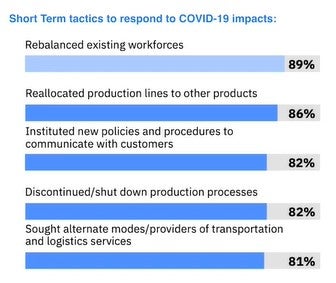Over the past six months, supply chain professionals have had to “dig deep” to get through what likely has been the most stressful time to work in this industry as a result of the coronavirus pandemic, according to Jonathan Wright, managing partner and global cognitive process re-engineering lead at IBM Services.
Wright, speaking at American Shipper’s Global Trade Tech summit on Wednesday, said executives had to break through some of the orthodoxies of the past to find new ways of meeting customer requirements to make sure they met their obligations.
To reduce the risk of a future wave of such heightened levels of stress, Wright says, those responsible for supply chain strategy and planning need to start looking through the windshield and not the rearview mirror.

“We look at historic sales, we look at historic data, we look at what worked last week or last season, and we base future predictions on what happened in the past,” Wright stressed. “In a stable environment, with moderate increases in GDP, that was OK. But we’re entering a period of high volatility. This volatility is not going to go away, whether we’re looking at COVID, whether we’re looking at trade, whether we’re looking at changing consumer behavior — volatility is the new norm and our supply chains need to be prepared for that.”
Wright explained that COVID-19 identified cracks and vulnerabilities in our supply chains — many of which companies knew about but decided not to make the investments they knew were required.
Some of the key weakness areas:
- A lack of real-time information: In what had been a relatively stable period prior to COVID-19, such information had been less valuable to an organization.
- A lack of real-time collaboration with partners and suppliers.
- The use of “serial” planning based largely on historic data.
But COVID has also appeared during a convergence of technologies such as blockchain, the Internet of Things (IoT), AI and machine learning, Wright pointed out.
“This gives us a huge opportunity to accelerate the improvements towards future supply chains. Changing the proposition. Looking at how we can make it easier for supply chain executives. What I call ‘cool’ work by making work much more empowering for our talent. And how we can get real-time balancing of supply and demand, and create self-learning, self-correcting supply chains.”
To get there, he says, supply chain organizations must create intelligent workflows to ensure that executives are focused on the important and not the urgent, “and on the strategic aspects that are driving continuous improvement and making sure that we delight our customers.”
Wright explained that intelligent workflows are about bringing resources together around a table — or a virtual table, in the post-COVID world — and not just looking at cross-silo handoffs.
“It’s about how we use internal and external data to make sure workflows are better informed. And then at the heart of our workflows, how we create a platform that brings AI, automation and new technologies like blockchain and IoT to make it easier for us to work on one version of the truth. So that whether you are working in a warehouse or in transportation or inventory management, that you are all working off one plan, one trusted data source, and can all access information at the same time.”
Such a strategy opens the door to what Wright considers to be the new integrated business planning model, called continuous intelligent planning. Instead of slow, time-based and series-based planning processes, companies must have continuous blocks of time where demand forecasting and real-time assessments are used to inform all aspects of supply chain, transportation, warehousing and inventory management.
“I think it’s hugely valuable,” Wright said. “It will avoid stockouts, inventory in the wrong place, and will drive much better on-shelf availability.”
Wright listed four takeaways for his audience:
- Leveraging AI and technology while creating a vision.
- Hardening solutions put in place while working through COVID-19. “You’ve found ways of doing work better through that period of time. We need to analyze those and make sure we get the investment dollars from the CFO to support integrating and hardening those solutions.
- Focusing on the human experience. “Applying technology is great, but let’s do it for a reason; let’s do it to make sure the human experience is better so we make supply chain professionals better versions of themselves, so that they can do ‘cool work’ and want to come to work because they want to have a great experience and add value.”
- Focusing on sustainability. “We need to do a lot more as we create future supply chains that are fit for the future generation.”











Metha singh
Nice article with useful information. thanks
Maticz
Useful information and thanks